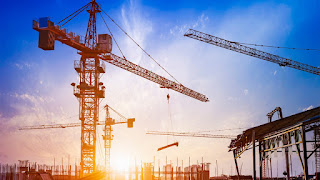Safety checklist to follow with tower crane for sale
In almost every
city's skylines, the telescopic tower cranes are visible. These are attached to
the sides of the structures allowing the operators to reach some great heights
offering superior lifting capacity with these stationary balance cranes that are
fixed to the ground on concrete slabs. We have discussed the most common types
of tower crane for sales and
noted that some of the larger ones could easily reach up to 1,400 feet in
height with a lifting capacity of over 100 tons in one of the previous posts.
With great power
comes great responsibility, as the saying goes despite OSHA and the National
Commission for the Certification of Crane Operators who are publishing a final rule that is scheduled for the tower crane operator certification in November
of 2019 as there have been several notable instances recently of the incidents
that involve the tower cranes.
Tower cranes are
some of the most expensive pieces of equipment on a construction site as they
are often the largest ones. When you are installing, operating, and
disassembling a tower crane, it is in everybody's best interest to take every
possible precaution. We have placed together some of the best tower cranes
safety checklists that include the common hazards that should be considered,
along with some of the best practices that can help keep your crane operators
and employees safe.
COMMON HAZARDS
Falling loads,
overloading and electrocution are some of the common tower crane-related
accidents occurring. In order to avoid stemming from them, the following are
some of the causes of these hazards and avoiding accidents:
Falling Loads:
Mechanical
failure, improperly secured loads, two blocking, and operator incompetency are
the causes of the falling loads though the snapped lines can also be caused by
the higher wind speeds.
To help avoid
these types of accidents, ensure that all crane operators, lifting supervisors,
riggers, etc., are properly certified and that certifications are up-to-date.
All loading procedures must be followed to the letter. Monitor weather
conditions before each shift and throughout the day.
Make sure that
all the crane operators, lifting supervisors, riggers are properly certified
and that the certifications are updated in order to avoid this kind of
accident. Before every weather condition, you need to consider each of the
sears throughout the entire day.
Overloading:
There is a a greater risk that the crane can suffer from stress fractures or, worse, collapse
completely, causing a hazard surrounding the equipment or the structures and
even death when the load of the crane exceeds its lifting capacity. Make sure
that no loads are over the lifting capacity of the cranes and that all the
loads are secured properly with the loading procedures.
Electrical Issues:
Cranes that
touch the power lines or other high-voltage power sources, including lightning
strikes is what half of all tower-crane-related accidents involve here.
Monitoring the weather throughout the day and making sure that there is
sufficient clearance for the jib to move is what should be considered.



Comments
Post a Comment